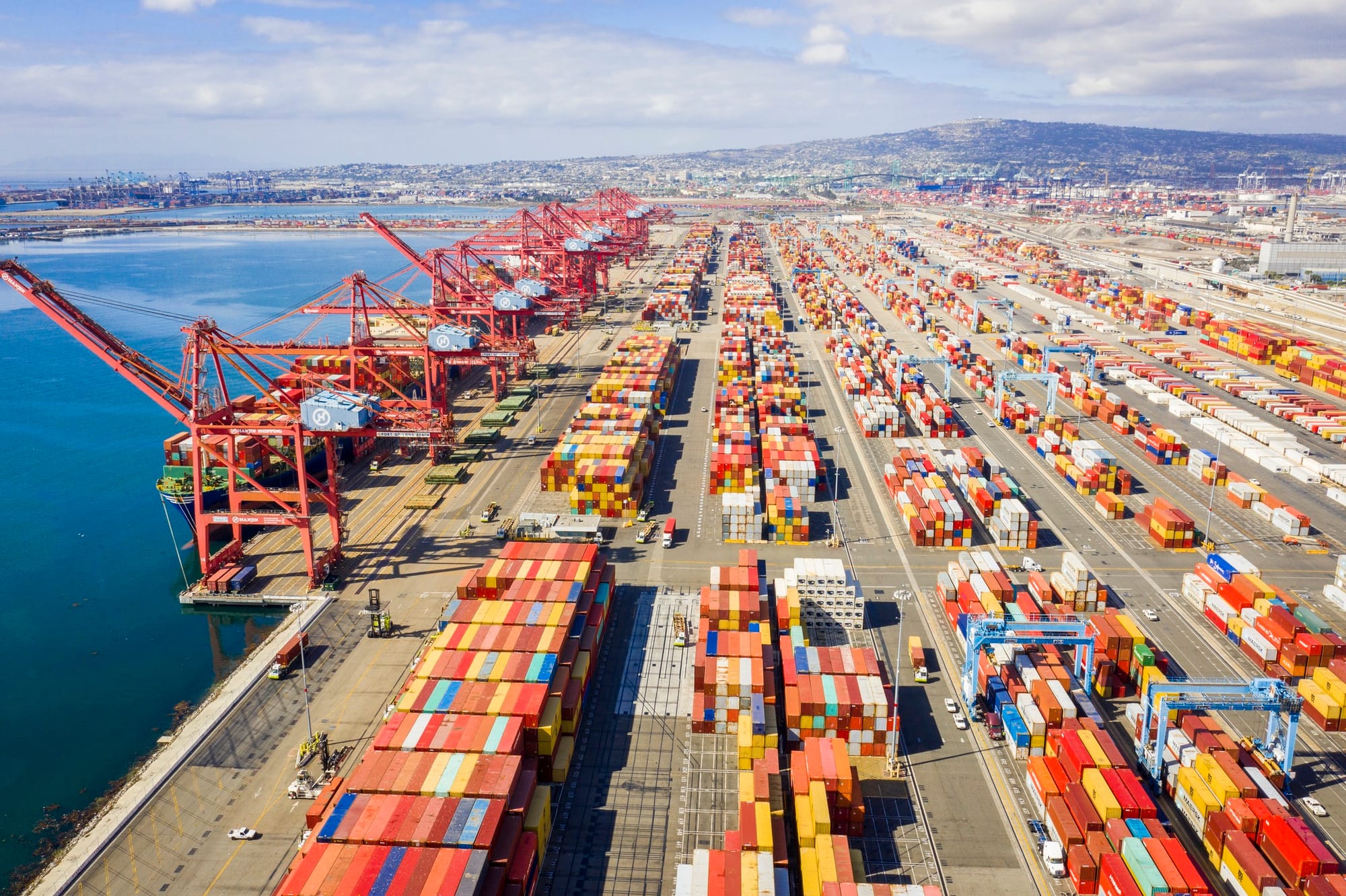US Grand Strategy: Global Trading Network
America should create a tiered global trading system

Originally published January 20, 2024
The primary question of our time is if a free and open society can compete with state-led autocracy. It can, but only by achieving its economic potential through the utilization of a global alliance network. Economic strength is the most important element of national power in the 21st century. The US is the largest market in the world and firms around the globe clamor to gain access to it. However, in the 21stcentury, American manufacturing capacity has migrated overseas where the cost of labor is lower. This deindustrialization has taken American jobs, devastated communities, and seriously impaired national security. To rebuild domestic industry, America should create a tiered global trading system. This post outlines what such a system would look like.
Free trade’s failures
Over the last forty years, the industrial heart has been ripped out of America. The causes and negative impacts of deindustrialization have been well documented (see “American Deindustrialization”). Left to a free market, other nations can, and have, enacted mercantilist trade policy that advantage their economy at the expense of American workers. This is especially true in Asia, where countries have manipulated their currencies, subsidized local firms, and have engaged in other “unfree” trade practices. This has led to the unemployment, wage suppression, and disaffection of large numbers of US workers. The laid off coal miner who should “learn to code” is a cartoonish example of how the problem can be solved through reskilling, but it is off the mark. Beyond jobs, the US needs a substantial industrial base to be a great power.
Historical US trade policy
Perfectly free trade and the categorical wrongness of government intervention in the economy is a relatively recent bipartisan myth. Alexander Hamilton advocated for and got tariffs to protect nascent US manufacturing from European rivals shortly after 1776. Tariffs of varying amounts existed throughout the 19th century and up until WW2. In fact, the post-war free trade era is a historical abnormality for America. Government investment in canals, railroads, and land (the Homestead Acts) dramatically increased the industrial capacity of the US. In the 20th century, the US government was heavily involved with the creation of Silicon Valley and the invention of the internet.
Global Trading Network
The US should create the Global Trading Network (GTN), a lattice of tiered trade alliances that will secure strategic supply chains, create American jobs, and enhance US foreign policy. In each tier, goods can only be traded amongst other members. Tier 1 will be comprised of goods that are strategic to US national security and must be produced inside the United States. Tier 2 goods can only be traded with military allies and tier 3 goods can only be traded amongst economic allies. Goods can be traded by any tier below their classification (e.g. a tier 3 good can be traded with a tier 2 partner). Commodities (raw materials such as agricultural goods, energy, and unrefined metals) are exempt from this system. Access to America’s massive market will serve as an enticing carrot in future diplomacy. If a country isn’t on the GTN list, they can still trade with the US but will be subject to separate bilateral trade terms.
Over the long-term, a “free-world” network of trade alliances will provide a self-sufficient, geoeconomic counterweight to the China-Russia axis. In the 21st century, military power is derived from productive capacity. By leading a global trade alliance network, the US will be able to outproduce its foes.
Tier 1
Goods in this category are considered strategic to US national security and must be produced inside the US. They may include, but are not limited to, PPE, semiconductors, certain pharmaceuticals, refined steel and aluminum, shipyards, casting and forging facilities, certain processed rare-earth metals and minerals, and the defense industry.
Tier 2
Goods in this category may be produced by US military allies, which are the NATO countries, New Zealand, Australia, Japan, South Korea, the Philippines, Thailand and Taiwan. Formal US allies are included in this tier because they have robust history of bilateral relations with the US and are able to manufacture sensitive, dual-use technologies. As an example, Japan produces high precision machinery, like Mitsubishi machine tools, that America imports. Under the GTN, this type of trade would continue as Japan is a formal US military ally.
Tier 3
Goods in this broad category may be produced by US economic allies, which should include, but not be limited to, Mexico, India, Brazil, Saudi Arabia, Vietnam and Turkey. For example, goods made in Brazil, like Embraer aircraft, would continue to be imported into the US. For Mexico, the biggest US trading partner, the terms of the USMCA would supersede the GTN.
4th Industrial Revolution
The application of AI, 5G, the Internet of Things (IoT), and other technologies applied to industrial processes has been branded the 4th industrial revolution. The first industrial revolution was about mechanization like the steam engine in the early-19thcentury, the 2nd industrial revolution was about railroads and chemical processes in the late-19th century, and the 3rd industrial revolution was about information technology in the late-20thcentury. AI, IoT, and 5G have not yet been adopted widely into American manufacturing but their potential is real. One criticism of the US is that there aren’t enough qualified workers and that labor costs are too high. That is the perfect environment to incubate the 4th industrial revolution, as firms are forced to invest to augment limited human labor.
Labor saving technologies will increase labor productivity and make US goods more competitive than anywhere else in the world. Far from taking workers jobs, no technological advance in history has permanently reduced human employment. The opposite is true: they have all been net job creators. For example, there have been far more 'driver' jobs created than carriage jobs lost. Furthermore, government policy has played a role in the last 3 industrial revolutions. The US had generally protectionist trade policy throughout the 19th century and the buildout of railroads featured massive public-private partnerships. A Department of Defense program spawned the internet. Perfectly free trade and markets are a relatively recent myth in America. The US should create a tiered global trading system to create domestic jobs, spur technological innovation, and augment its foreign policy.
The Global Trading Network is a pivot away from the failed experiment of unrestricted free trade. By creating a three-tiered system that prioritizes domestic production of strategic goods, strengthens military alliances through preferential trade access, and builds economic partnerships with key markets, the GTN would simultaneously rebuild American industrial capacity, secure critical supply chains, and create a "free-world" economic bloc capable of outcompeting authoritarian rivals like China and Russia. Combined with the adoption of 4th Industrial Revolution technologies that can overcome labor cost disadvantages through productivity gains, this framework offers a path for democratic nations to reclaim their economic sovereignty while maintaining the collaborative advantages that make open societies superior to autocratic alternatives in the long run.
August 3 2025 update: The August 2025 global trading system is starting to resemble the GTN in all but name. Starting on April 1, 2025, President Trump has begun the process of rerouting global trade flows, historical routes set at the end of WW2, 80 years ago.
In the news last week, the US signed trade deals at a tariff rate of 15% with Japan, South Korea, and the European Union, all tier 2 military allies under the hypothetical GTN. Deals with Canada and Mexico, the US' biggest trading partners, are still forthcoming - and President Trump has signaled an intent to come to terms with both countries.
Rare earth minerals, designated as tier 1 homeland goods in my framework, have become a massive issue and China's trump card in negotiations. It is critical that the US become self sufficient in rare earth minerals processing if it wants to end its dependence on China.

This is the second installment in citizen journal's American Grand Strategy for a Multipolar World multi-part series. The series contains 7 white papers: 2 global policies and 5 country-level strategies.
1. Introduction
2. Global trading alliance network
3. China
4. Russia
5. Middle East
6. Mexico
7. India
citizen journal offers three flagship products: a daily national news summary, a daily Kansas news summary, and local news and school board summaries from 12 cities across Kansas. Each issue contains 5 paragraph-length stories that are made to be read in 5 minutes. Use the links in the header to navigate to national, kansas, and local coverage. Subscribe to each, some, or all to get an email when new issues are published for FREE!
Contact: greg@citizenjournal.us


